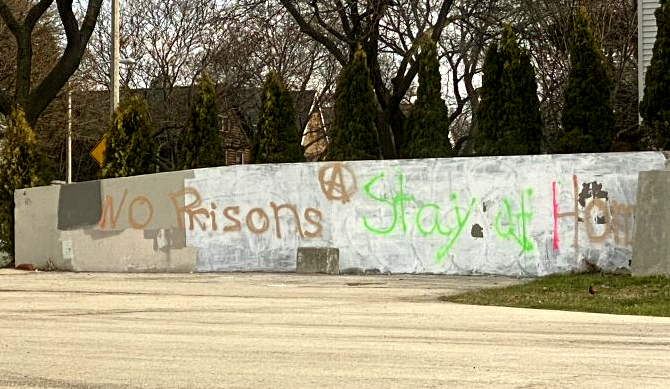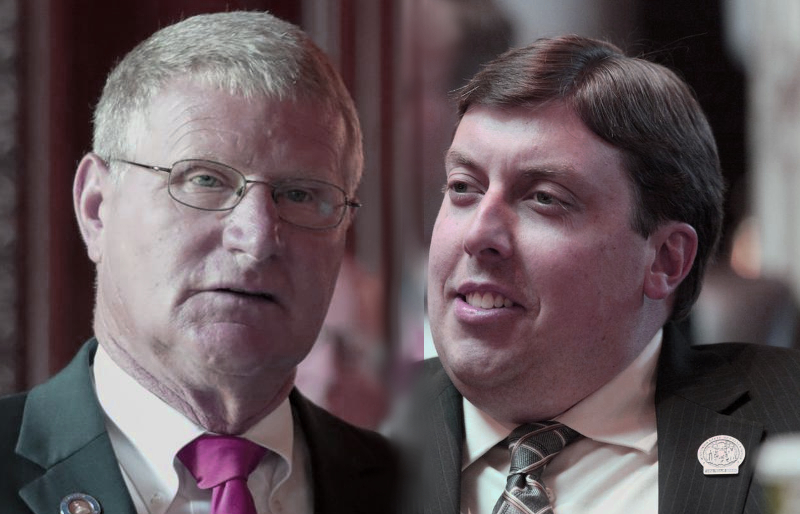
Politicians in Madison want to build a prison, maybe two prisons. They want more cages in this state to hold people in. The leadership of both parties have prison-expansion plans in the upcoming budget, and if we do not fight back, these plans will go forward. More of our friends and neighbors will live behind bars. More people will suffer in solitary confinement. More will face racial or gender harassment, terror, negligence and abuse from prison guards as well as from medical and psychological staff.
We cannot allow this to happen.
This is the second article in our Fight Prison Expansion series. The first covered where and when we will fight: the upcoming Joint Finance Committee hearings. This article will discuss what and who. We’ll break down the budget process, who is behind that process, and what they’ve done to expand prison so far.
Wisconsin’s prison population has declined over the last year, but we cannot let that fact make us too comfortable. The decline was caused mostly by the pandemic slowing court processes. The fact is, both parties are eagerly at work to expand the prison system’s capacity, showing their intention to reverse the pandemic trend and return to increased incarceration in this state.
The What: Wisconsin’s budget process
Wisconsin’s process treats the budget like a hot potato tossed back and forth between the Governor and the State Legislature. So far, the Governor has proposed a budget, which the legislature can either amend, or re-write from scratch. Their budget will pass later this spring, and the Governor will go through it with a line-item veto to remove provisions and programs he doesn’t like. He cannot reinsert anything from his budget, only remove items from theirs.
This process is designed to facilitate negotiation and compromise between parties representing different parts of Wisconsin. In recent years, the possibility of compromise has broken down, because ideologically rigid and bureaucratically ruthless Republicans have usurped leadership power by gerrymandering the legislature.
We cannot overstate the impact of this gerrymandering. In 2018, 54% of voters cast ballots for Democrats, but Republicans took 64% of seats, the skew persisted in the 2020 race. Some lawyers sued over the gerrymander, but the same bureaucratic ruthlessness runs through national politics as well. The Republicans have stacked amerika’s supreme court with arch conservative ideologues and rapists who they hope will help steal more elections, like the court did 20 years ago.
Even these ethically bankrupt stooges couldn’t endorse what Republicans did to the people of Wisconsin. When asked to take a side, they lacked a good legal argument in favor of their team, so instead, they averted their eyes, mumbled and shrugged it off.
Last year’s census created an opportunity to redraw legislative districts and eliminate gerrymandering. The Governor created a commission, and activists are pushing for fair maps, but the final authority lies with the legislature, the very people who made skewed maps in the first place.
In short, we need to understand that the budget process we are fighting is not a legitimate democratic process. It is an imposition. The resulting budget will not be a moral document showing the values of our society, because the process of drafting it actively excluded most of us. Not a “people’s budget,” Wisconsin will instead have a toxic negotiation between a weak, mild-mannered liberal and an aggressive group of perverse white supremacists.
The Who: a Three-way Fight
Let’s look deeper at the two main players in the official budget fight, and a powerful, but silent third player. The Democratic Governor and the Republican Legislative leadership are the main players. How they’ve behaved in the past can help us anticipate and prepare to effectively impact the process this time.
Under current Republican leadership Wisconsin’s state legislature is a deeply and overtly white supremacist institution. Their policies consistently and aggressively pursue harm for non-white people. Like all white supremacist organizations, they also hurt low-income white people, while using racialized fear and resentment to distract and justify neglecting even white peoples’ real needs. In Wisconsin, gerrymandering, segregation, and our conflict-avoidant culture have come together to take these toxic politics far.
On a more specific level, most of the budget work will be done by the Joint Finance Committee. This group is formed of all members of the senate and assembly’s finance committees, whose membership reflects party affiliation of seats in the gerrymandered legislature. That means there are 12 Republicans and 4 Democrats. With such a commanding majority, the Republicans have near-total control of the budget-making process.

The co-chairs of the Joint Finance Committee are Assembly Representative Mark Born and Senator Howard Marklein. Born is a county sheriff from Dodge county. He helped block medicaid expansion funds, withheld funds owed to Milwaukee and Madison for Trump’s spurious election vote recount, and tried to force teachers back to work before it was pandemic-safe. Marklein is an accountant from southwest Wisconsin who represents corporate-backed special interests over his constituents.
Marklein replaced Senator Alberta Darling, who represents a district on Milwaukee’s north suburbs. Her district’s population has shifted in the 10 years since the gerrymander fix, making it a potentially less secure red seat. Removing a senator facing pressure from Democratic voters in her district with one from a solid and deep red district hardens far right resolve going into the budget process.
Meanwhile, the major opposing player is Democratic Governor Tony Evers. This spineless centrist was born to a doctor’s family in a small town. He went to college at UW-Madison, then worked in a few small town and suburban school districts across the state. In 2001 he moved back to Madison to work in the Department of Education bureaucracy. This life of small towns and establishment Madison institutions hasn’t prepared him to represent or understand, let alone address the needs of his urban and non-white constituents.
On the campaign trail, Governor Evers made all the standard liberal promises. He said he’d reduce the prison system by 50% and close MSDF. He (like almost every Democratic candidate) said yes to everything that reformists asked. It became clear within his first few months in office that he hadn’t meant any of it. Tony Evers cannot be trusted to adequately defend Wisconsin’s communities of color against the white supremacist aggressions of legislative leadership.
There are some side players in each party, but they have mostly allowed themselves to be marginalized. Moderate Republicans rarely break with party leadership. Likewise, Governor Evers and his centrists, while failing to stand up to Republicans, have successfully stifled public criticism from progressives in the Democratic Party. Some Black politicians from Milwaukee let themselves be tokenized by the Governor. Others have engaged in bizarre and harmful deal-making with Republicans. None have publicly criticized or broke with party leadership. They could have called on the governor to stiffen up and bypass the racist legislature, for example, using his pardon power to protect incarcerated people from the covid19 pandemic.
The third player in this fight, the one that could be stronger than the rest, but has thus far been inactive is us: the people. While we are most impacted by budget decision-making, we are also the most removed from the process.
The degree of prison expansion in this budget will profoundly re-shape life in police-targeted communities. Wisconsin has been on a path of increased governmental violence against Black, Brown, Indiginous, and low-income white communities in recent decades. The state already has more prison guards than any other single governmental position. The City of Milwaukee spends nearly half its budget on cops who put people in prison at extremely high rates.
Organizers have challenged these institutions. Modest progress has been made on defunding the Milwaukee police department, but if we do not rise up definitively against rising investment in prison from both parties, we will see these institutions consume all other priorities.
Results of the Last Cycle
Prison reform was almost non-existent in Governor Evrs’ 2019 proposed budget. He proposed meager TAD funding which he later claimed was only so low by mistake. The TAD funding was cancelled out by his proposed expansions: pay raises for prison staff, a $8.1 million four-year investment in MSDF, and two new “temporary” barracks to relieve overcrowding in the system.
The Republicans’ counter budget reduced TAD funding, increased guard pay raises and kept the MSDF funds, but replaced the Governor’s barracks with a huge, expensive new prison. The Governor vetoed that prison.
So, in 2019, both primary budget players wanted to expand Wisconsin’s prison system, to different degrees. The only reason they didn’t is because they could not overcome partisanship and negotiate with each other. We should not rely on something like that happening again.
Expansionists argued that increased capacity was necessary because of overcrowding, and that pay raises were needed to address understaffing. In response to these arguments, Forum for Understanding Prisons did some record requests and published a report titled “Staffing, Crowding, and Death in the Wisconsin DOC”. That report found that overcrowding is indeed a serious problem. People suffer terribly and die frequently in Wisconsin prisons. It is nothing short of an ongoing and ignored humanitarian disaster. On the other hand, understaffing, especially guard understaffing, is not a real problem. Looking closer at the data, we can see that Wisconsin has more guards per captives than national averages, but high turnover is the actual problem. Being a prison guard is a terrible, trauma-inducing, and soul-crushing job few want to do long term.
Raising wages to lure more people into these toxic jobs is a cruel, and likely ineffective solution. A lack of qualified guards makes facility expansion an absurd response to overcrowding. Who will work at the new prisons? How much more will taxpayers have to pay to convince people to staff these desolate facilities? Staff instability and crowding are clearly better solved by releasing people from prison.
Unfortunately, since the last budget, the legislature passed bills to expand incarceration. The Governor vetoed their efforts, but also failed to take decisive action to reduce the prison population. Even with the above-mentioned temporary population reduction caused by covid19, some prisons remain operating at 120-140% of capacity and the system as a whole is overcrowded to 111%. Once courts reopen post-covid, we should expect this overcrowding to skyrocket back to previous horrific levels.
Its not surprising that white supremacist Republicans don’t want Black, Brown, and Indigenous people to be free. First, it seems they want a new prison so they can overcrowd it and hurt more people. Second, they want to trick rural constituents into taking jobs that look good on paper, but will actually destroy their lives.
Democrats could bypass these white supremacists and protect their constituents. The Governor can always expand his pardon criteria to include incarcerated people. He wouldn’t do it when republican governors elsewhere did, when the pandemic broke out, when it spread to infect half Wiscosonsin’s prison captives, and he wouldn’t even do it to re-enfranchise voters and ensure a presidential victory for his party. Will he do it to save the state millions in prison expansion costs? Will he do it to end the abuse and the humanitarian crisis? It seems unlikely.
Youth Prisons: Another Bipartisan Prison Expansion
There is no clearer demonstration of Wisconsin’s bipartisan commitment to atrocity and waste than the story of Act 185. This law passed in 2018 in response to horrific abuse in youth facilities up north. Rather than closing the facilities, addressing abusive staff, or rescuing children from harm, the legislature passed this compromise, which Governor Scott Walker signed into law under public pressure. Act 185 was supposed to convert Lincoln Hills and Copper Lake into adult facilities and build six new youth facilities across the state. It would have added hundreds of total cages/beds to both the adult and youth systems. Solid organizing from Milwaukee activists, combined with partisan in-fighting, has stalled this expansion, and allowed for the removal of most children from the facilities. The Copper Lake / Lincoln Hills facilities currently hold 89 youth, at a cost of $600-$800 per child, per day.
Media campaigns by the guard union and corporate outlets have villainized and dehumanized youth held at Lincoln Hills, so Republicans no longer feel pressure to close the facilities. They’ve backed out of the deal. Unimaginative Democrat politicians remain committed to their bad compromise plan, however, begging for more money to build new youth prisons. Governor Evers’ proposed capital budget includes $45.8 million for a youth facility in Milwaukee, which would house 32 youth at a cost of $7.7 million per year.
That’s right, rather than investing in community and family support, Wisconsin liberals want to spend $1.4 million per child on new cages, and then $240,000 per year, per child operating them. Republicans, it seems, prefer rounding up more kids, and refilling the 600+ cage facility where the children were routinely abused and killed by suicide. Unsurprisingly, despite covid-induced population reductions, a new report from the court-appointed monitor shows that staff have not stopped abusing children.
If the Governor and the legislature won’t shift from prison expansion to decarceration even when it comes to children, what is it going to take to shift them?
We’ll tackle that question in the next piece in our series: Prison Expansion: How We Fight.
